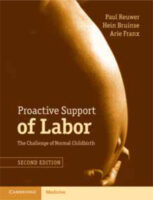Main content
Introduction
Medical staff involved in obstetric care across the globe are confronted with several challenges. Important issues are the rising rate of caesarean deliveries and their sequelae, high instrumental delivery rates in some centres, medical litigation issues, and psychological harm to patients who do not experience spontaneous vaginal delivery within a reasonable time. At the Livive birth centre in Tilburg, the Netherlands, the authors have introduced the concept of ‘proactive support of labour’ in order to systematically tackle these issues. It is in fact an adaptation of an approach advocated by O’Driscoll in Dublin during the 1970-80s. The proactive support of labour concept was developed to enhance patient satisfaction concerning obstetric care and safely reduce caesarean section rates. It only deals with singleton, cephalic, term pregnancies.
Wake-up call
Much can go wrong in modern obstetrics and midwifery, as the authors recognize ‘a progressive lack of understanding of the labour process and, consequently, declining delivery skills of today’s birth professionals’. Extensive support for this provocative statement is provided. Rising caesarean section rates are seen as indicative of the problem of failing childbirth methods, in particular during the first stage of labour. What are the causes? Among others, the lack of a systematic approach to the first stage of labour, insufficient professional interest and poor counselling are mentioned. The book provides a critical evaluation of recent clinical research, including a meta-analysis that shows lower caesarean section rates among patients undergoing induction of labour.
In the second section, the book goes back to basics and provides an overview of the physiology of labour. It emphasizes the parasympathetic nature of labour, and the potentially harmful effect of stress. The importance of the physiological process of electromechanical coupling in the uterine muscle prior to delivery is described, and the possible negative consequences of induction on this process. Attention is placed on the importance of precise and consequent terminology during staff handovers.
What can be done?
The third section describes the proactive approach in detail. Essential is the correct diagnosis of labour, for which clear definitions are provided. Timely augmentation of labour, with rupture of membranes or use of oxytocin, is essential to ensure progression. A distinction between mechanic dystocia (in case of cephalo-pelvic disproportion) and dynamic dystocia is made and several causes of dynamic dystocia are unravelled, emphasizing the differences in case management between nulli- and multiparous women. The authors provide management guidelines for each type of obstructed labour. Emphasis is put on adequate pre-labour preparation and counselling, including the option of conducting a caesarean section if delivery is not imminent after 12 hours of labour. One-on-one nursing care is considered an essential component of the approach, which will require some organizational reform in most hospitals.
Discussion
This book is worthwhile reading for everybody involved in birth care, especially for junior staff with limited obstetric training. The provocative style may not appeal to everyone, but it makes for an interesting read. If offers an overarching philosophy of labour and delivery, based on a solid understanding of physiology, which would increase the quality of care on labour and delivery wards both in high and low income settings. Unlike many other medical textbooks, this book does not deal only with purely medical problems and solutions but also with the organization of care, the importance of patient satisfaction and proper counselling, thereby offering a holistic approach.
The authors may encounter some resistance in denouncing the concept of latent phase of labour. Early interventions during the first stage might not appeal to all practitioners either but are worth discussing. Practitioners who read this book will be triggered to evaluate their own practice. It is a good teaching resource in developing countries and provides a good starting point for cooperation between primary and secondary care providers.
Details

Reuwer P, Bruinse H, Franx A. Proactive support of labour: The challenge of normal childbirth (2nd edition).
Cambridge: Cambridge University Press; 2015 – Paperback, 203 pages


















































